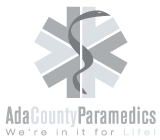Written By: Mary Anne Pace
EMS education has had a fickle history, to say the least. Depending on which medic you talk to, they will tell you they took their paramedic training through a community college, a fire service, an ambulance service, a university, online, etc.etc.etc.
When I first came to work at Ada County Paramedics five years ago, I thought, why this can’t be. These people know so much! How is it there is absolutely no standard for EMS education, and how is it possible they don’t receive a college degree when they’re finished with their extensive training?!! Truly, EMS education has had its share of renditions, comedy, torment, inconsistencies and anything else you care to call it over the roughly 50 years of our profession’s history.
I figured out that a whole bunch of EMS people have been pondering how to standardize EMS education for years, as is evidenced by the sheer number of EMS education papers published over the past 13 years: National EMS Education Agenda (2000), National EMS Core Content (2005), National EMS Scope of Practice Model (2006), National EMS Education Standards (2009)…and there are more, lots more. They never seem to end. Just when you think you understand what to do as an EMS educator, everything changes. I’m so confused by all these documents that I have a tendency to discount them all and just stick to what is required in our state.
Alas, it’s my job to figure out how to help train these medics to be the best medics they can be, so that when they arrive at your house at 3 AM, you will get the best care possible. I’ve had my own traumas trying to figure out all these national guidelines. I have had better luck, however, identifying trends in EMS education. The following list includes the trends in EMS education which are happening right now in our community and around the world, in no particular order.
1. More EMS Research
Something that has been hugely lacking in our profession, and hugely necessary if we are to continue to innovate and produce the highest quality practitioners. Thanks to those formal papers which I couldn’t make sense of, folks have begun to realize how important valid research is to our profession, so that we can offer the best care to our community and beyond.
2. Expanded Scope of Practice
Or at least a different way of utilizing our current skills. This will be implemented by using Community Paramedics and other primary care and advanced care EMS workers, working in partnership with other health care providers in the whole system.
3. System-wide and Regional Service Structures
Budgets have become too constrained to allow service overlap within a system or geographic area. Many agencies will consolidate operations, changing the way we offer education. This is actually a good thing, because patient care will become more comprehensive with less redundancy.
4. System-Wide Protocols for Specific Health Events
What we are learning about many health conditions like heart attacks and strokes, is that the faster a patient receives definitive care, the more likely he or she is to have a positive outcome. So the whole patient process is being streamlined, starting with EMS providers at your front door, and ending with definitive hospital care.
5. More Simulation During EMS Training and After
For a variety of reasons, it is getting more and more difficult to learn EMS skills in a hospital setting. Fortunately, simulation mannequins have improved so much that we can now utilize them to create an almost-real-life environment. Not quite…but getting better all the time.
6. Health Care Reform
I don’t even know what to say about this except that it is driving many of the other trends, and it will impact almost everything we do, including our education.
7. Integrating Technology, Virtual Environments and Distance Education Models into the EMS Classroom
Some of these trends will require more education. Some will require stronger relationships with partner agencies. Some will require some expensive purchases by EMS agencies. But most of these changes will mean that medics will provide you with better and better care as time goes on.
For more information about Ada County Paramedics, like us on Facebook, follow us on Twitter and visit us on the web!


